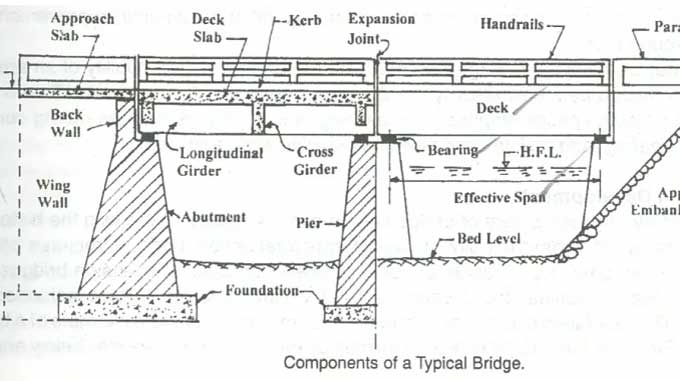
Classification of Bridges & Components of Bridge Engineering
Bridges allow the conveyance of road traffic or other moving loads over depressions or obstructions such as rivers, streams, channels, and roads. Individuality is the essence of it. Though many of the bridge types used today are not immediately apparent, the history of gigantic bridges is hardly a century old.
Bridge Classification
- Based on the Construction material.
- Loading based.
- Depending on the purpose.
- Alignment based.
- Superstructure type.
- Low cast bridge.
1. Based on the Construction Material
Steel Bridge
Bridges made of steel are used for a number of different things, like securing pipelines and carrying highways.
Pre-stressed Concrete Bridge
There are fewer expansion joints in pre-stressed concrete bridges; the prestressed members are lighter and best suited for artistic and architectural applications.
Compared to steel, high tensile steel is more expensive when used in precast concrete and reinforced ember structures.
RCC Bridge
Following the dominance of stone in the history of the building, it was cast iron and steel that attracted the engineers' interest.
There is no need to clean or paint every five years. A maintenance-free structure believes to be possible with RCC construction.
2. Loading Based
AA Class
As defined in the original classification method of defense authority, the class AA loading matches the class 70 loading.
A Class
Various types of vehicles are expected to have different combinations of axle load and axle spacing, which led to the proposed class loading system.
B Class
With its reduced axle load and tire contact dimensions, it is similar to the class A train of the vehicle.
3. Depending on the Purpose
Railway Bridge
The floor of narrow railway bridges carries lighter loads is supported by a slab cast in situ or a slab cast in situ.
Viaduct Bridge
It consists of a series of spans over bent trestles of the solid pier that carry a road or railways across a dry valley like a bridge.
Footbridge
Footbridges are bridges designed for pedestrians, bicycles, and animals only.
4. Alignment Based
Straight Bridge
Straight Bridge is the bridge at right angle to the axis of the river.
Skew Bridge
This type of the bridge is not at right angles to the axis of the river.
5. Superstructure Type
Suspension Bridge
Cables are strung on a curve in suspension bridges, and they support the roadway from there. Stiffening occurs over a very long span where there is a high ratio between dead and moving loads.
Balanced Cantilevered Bridge
Spans are supported over cantilevers and are balancing cantilever bridges. Spans between 35 and 60 meters can be achieved with this equipment. Additionally, they can be used across deep gorges by means of single spans when centered bridges are impossible.
6. Low Cast Bridge
The term low cast bridge refers to bridges that are cost-effective to construct and maintain. Insufficient resources, money, time, or skills, in the case of a permanent work need as well as a temporary one.
Components of Bridge
Superstructure
Superstructures of bridges are analogous to roofs of single-story buildings and substructures to walls, columns, and foundations. Communication lines run through the superstructure. Handrails, guards, stones, arches, beams, girders, & cables support the flooring.
Substructure
A superstructure is supported by a substructure. The foundation consists of the following components: abutments, piers.
Wrapping it Up
Overcoming obstacles with a bridge does not place the route in danger. Passages may be needed for a road, for a railway, for pedestrians, for a canal, or a pipeline. You may have to cross a river, railway, or valley using a bridge.
To get more details, watch the following video tutorial.
Video Source: Civil Notebook


